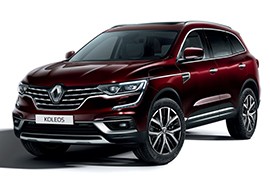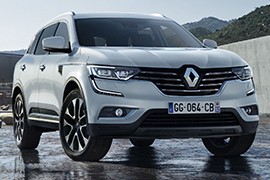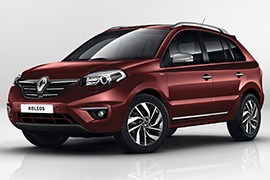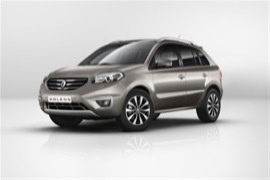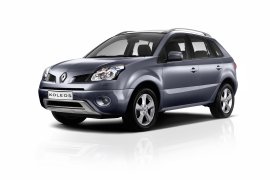RENAULT Koleos Models/Series Timeline, Specifications & Photos
First production year: 2007
Engines: Diesel, Gasoline
Body style: SUV (Sports Utility Vehicle)
Just two years after launching the second generation of the Koleos, Renault gave it a facelift to boost sales, but the result was below expectations.
The Koleos was a mid-size crossover with a French attitude based on the same platform as the Nissan X-Trail (or the Rogue in the U.S.) and the Samsung QM6. Unfortunately for Renault, customers didn't recognize the French automaker as a trustworthy 4x4 manufacturer, so it didn't succeed with it. It struggled to get a six-figure annual sales but it couldn't. Moreover, in Europe, it managed to get a five-figure number just for three years.
The refreshed version was quite a looker. Its front fascia sported big LED headlights from the mid-trim level and daytime running lights that were extended from the headlamps to the bumper. In addition, several chromed details on the grille and the fog lamps' scoops adorned the vehicle. Moving on the profile, the automaker added more shiny ornaments to the doors' surroundings, door handles, and front fenders. Still, the carmaker's design team made it bold but not too flashy.
Inside, customers found bolstered front seats separated by a tall center console. Moving on to the dashboard, the automaker integrated the infotainment system into the center stack but kept some of the physical buttons. Renault installed a mixed panel inside the instrument cluster with a center-mounted digital tachometer flanked by the fuel level and the water temperature gauges. At the back, the split-folding bench-seat was wide enough to accommodate three adults, and the center tunnel was not too tall.
Renault offered the Koleos with either a front or an all-wheel drive system and installed gasoline or turbo-diesel engines underneath its mid-sized SUV's hood, depending on the market.
The French manufacturer revealed its new generation of the D-segment SUV Koleos in 2016 in China. In keeping with the Renault design strategy introduced by Laurens van den Acker, the new Koleos is covered by a so-called design pillar “EXPLORE”, which stands for robustness and a taste for adventure.
The new Koleos increased in size compared to the previous generation, reaching 4.67m in length (183.8 in) ,leaving more room for the five passengers inside. From the LED headlights (depending on versions) there are strips that run along the wings to visually lengthen the front end and induce an impression of dynamism.
Inside, the driver has a TFT 7” instrument cluster plus the the new R-Link 2 with Android Auto and Apple CarPlay connectivity, which can be ordered either as a 7” landscape mode or a 8.7 inch portrait. The whole interior lightning uses LED technology. For long trips or weekly supplies, Renault made a 542 liters (19.1 cu-ft) trunk, which can be extended up to 1690 liters (59.6 cu-ft). Last but not least, the new Koleos' cabin is particularly bright thanks to a large, opening glass sun roof 0.80 sq-m (8.6 sq-ft) in size, which extends over the rear seats.
The car's powertrains have been developed within the Alliance and, depending on the market, the model is available with either gasoline or diesel engines, with power outputs ranging from 130 to 175 hp. The transmissions available are either 6-speed manual or an X-Tronic CVT.
Renault introduced the Koleos in 2010 as its first SUV built together with Samsung Motors and introduced a facelift for it in 2013.
The French carmaker chose the Buenos Aires Motor Show to unveil the facelifted version of its SUV, the Koleos. It was built together with its Korean partner, Samsung Motors, and updated with technological items and up to date design cues that fit Renault's style.
The facelifted Koleos incorporated the French carmaker's new design elements on its street vehicles, such as the Laguna-inspired headlights. Its grille looked wider and sported chromed horizontal slats that supported the bigger rhomboidal Renault badge at the front. In the rear, the taillights were identical to those installed on the first, non-facelifted, Koleos.
Inside, the designers' team went wild with plenty of modifications, which started from the infotainment system and ending with the seats. An R-Link unit took center stage of the dashboard and brought together more controls for the climate control and the audio system. Renault installed a new safety system, named Blind Spot Warning, which helped the driver while overtaking and provided a visual alert when another vehicle was in the blind spot.
Under the hood, Renault offered a small choice of diesel and gasoline engines, paired to either a manual or an automatic (CVT) gearbox.
After a few difficult years affected by the world financial crisis, Renault tried to get back on its fit faster than its competitors and introduced a facelifted version of its biggest SUV, the Koleos.
The market had already shifted towards crossovers and SUVs, and it looked like there was no turning back to regular sedans and MPVs as people carriers. But Renault had both of them and ruled the European market in the minivan segment. But it wasn’t seen as a trustworthy SUV maker, so it tried to fix that by unveiling a refreshed and improved version of the Koleos. Even if it was its biggest high-rider, the car still belonged to the compact crossover segment and shared its platform with the Samsung QM5, and both siblings were built in Korea. But, unfortunately for the French automaker, sales for the Koleos continued to drop despite the enhancements brought by the 2011 version.
Renault installed a completely new front fascia for the facelifted Koleos. It ditched the formerly used “wing design” and adopted a broad grille crossed by three horizontal slats and surrounded by a thin chromed rim. New headlights with projector beams and LED daytime running lights flanked it. The French automaker put a light-gray plastic underbody shield on the lower bumper and two side scoops for the fog lamps. From its profile, the 2011 Koleos revealed another update: turn signals installed on the door mirrors and, depending on the trim level, body-colored or silver caps for them. At the back, the raked-forward tailgate gave the crossover a dynamic image, even though the automaker tried to sell the Koleos as a family vehicle fit for school runs and weekly shopping.
Inside, Renault kept the same high-mounted seats as on its predecessor, and only the driver could adjust the seat height, while the side passengers had to rub their heads on the roof liner. Still, there was a slightly improved design for the instrument cluster, which boasted light-gray lettering, easier to read, instead of the faded ones from the non-facelifted version of the Koleos. To improve the cabin’s look, the automaker also changed the design of the buttons and switches on the center stack. In the back, there was still enough room for three adult-sized passengers, with plenty of legroom and headroom.
Renault updated the Koleos in 2011, even if it didn’t have to. The Euro 5 emission standards came into force in 2009, and the Euro 6 were due in 2014, so the French automaker didn’t have a reason to upgrade it from a technical point of view. As a result, most of the drivetrains were carried over from the 2008 Koleos, but the automaker added a new powerplant: a 2.0-liter turbodiesel that offered 175 PS (169 HP).
Renault rebadged the Korean Samsung QM5 and sold it in Europe as the Koleos, a daring offer in the SUV/crossover segment where the French automaker was poorly represented.
In 2006 Renault introduced the Koleos at the Paris Motor Show, and sales started soon, with deliveries in 2007. But unfortunately for the French automaker, the world financial crisis struck hard the automotive industry, and the market drastically dropped. In addition, those looking for such kind of vehicle were mainly focused on brands that had a tradition of building SUVs and crossovers, not Renault. As a result, the Koleos was sold in less than 150,000 units in almost ten years.
Following the same design language as the rest of the Renault range, the Koleos featured a pair of headlights swept back above the hood, flanking the "beak-bird" grille imagined by Patrick Le Quement. From its profile, the Koleos showed an arched line for the greenhouse, ended at the back by a raked-forward tailgate and C-pillars.
The interior was neatly organized, with a design that abounded in curved surfaces and a waved shape for the dashboard's midsection. Renault also placed high-mounted seats, typical for an SUV. At the back, the split-folding bench could expand the trunk space, transforming the French SUV into a practical family vehicle with some off-road abilities.
Under the hood, Renault installed a choice of gasoline and diesel engines that sent power in all corners via either a six-speed manual or an automatic transmission.
